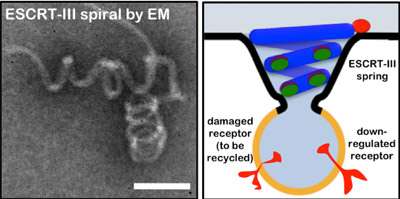Study shows how cells form 'trash bags' for recycling waste

(Phys.org)—To remove waste from cells, a class of membrane-sculpting proteins create vesicles—molecular trash bags—that carry old and damaged proteins from the surface of cellular compartments into internal recycling plants where the waste is degraded and components are reused.
A Cornell study in the Oct. 12 issue of Cell may explain how these membrane-sculpting proteins, known as Endosomal Sorting Complexes Required for Transport (ESCRTs), create vesicles, a process that has remained a mystery since ESCRTs were discovered more than a decade ago.
If these "trash bags" are unable to make their deliveries, numerous diseases including cancer and neurodegenerative diseases emerge. Furthermore, viruses like HIV can hijack these membrane-sculpting proteins to burst out of infected cells.
The study was led by Mike Henne and Nicholas Buchkovich, postdoctoral researchers in the lab of Scott Emr, the paper's senior author and director of Cornell's Weill Institute for Cell and Molecular Biology. It describes how the researchers reconstituted a portion of the ESCRT machinery—a complex known as ESCRT-III—that bends the cellular membranes, a key step before the envelope eventually pinches off and closes to form vesicles. The researchers then visualized the membrane-bending process using a high-power electron microscope.
The researchers were able to show that proteins within the ESCRT-III complex work in stages where one protein assembles into spirals while other proteins transform these spirals further into tighter corkscrew-shaped helices, which then bend the cellular membrane prior to it forming into a vesicle.
"We believe these experiments tell us that ESCRT-III is a dynamic complex that generates vesicles by forming a spring-like filament that can bend membranes," Henne said. If true, this could be a novel method for creating membrane curvature in cells, he added.
Altogether, the ESCRT machinery is composed of five distinct complexes that must work together to do their job. These complexes are thought to recruit one another to the surface of vesicles in a specific sequence of events.
After visualizing the ESCRT-III complex, the researchers examined how ESCRT-III interacts with its neighbor and recruiter, ESCRT-II. They found that ESCRT-II controlled ESCRT-III architecture, but also works with ESCRT-III to create tiny ESCRT-III rings on the membrane surface. Since ESCRT-II contains a specialized protein responsible for grabbing trash, the researchers believe that ESCRT-II and ESCRT-III work together to first grab and then trap cellular garbage in this ESCRT-III ring before the ring eventually matures into the membrane bending spring.
Vesicles hold different cellular materials, and many of them carry protein waste. They also regulate cell-signaling receptors at the cell surface by internalizing them and thereby shutting them down, before they are carried to the cell's recycling plants, known as lysosomes, where they are degraded by digestive enzymes.
Uncovering these steps of the process opens the door for future research by Emr's lab to explore exactly how the final moment of vesicle formation—the "pinching off" step that seals the top of the vesicular bag known as "scission"—is mediated. Vesicle scission remains one of the outstanding questions in the field.
Journal information: Cell
Provided by Cornell University


















